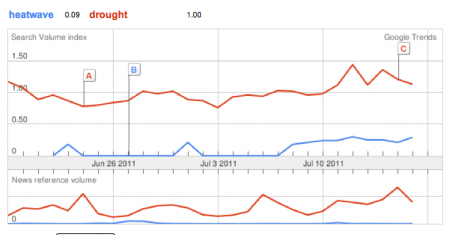Although we write about the impact of climate change on agricultural biodiversity, and the need for biodiversity in plans to adapt agriculture to climate change, this is not a climate change blog. If it were, I’d be writing at length about some strange stuff going down.
The US is facing both a drought and a heatwave. The drought is getting a lot of attention, the heatwave, not so much. The thing is, as Michael J. Roberts points out, the drought isn’t as bad as it looks, partly because there is irrigation where it seems worst, and partly because “standard drought indicators don’t predict crop outcomes especially well”.
The heat may be far more important for crop yields especially coming, as it is, at a sensitive time, as the corn (maize) begins to blossom.
Roberts, an economist, is thus “much more bullish” about corn prices. That is, he expects them to go up, not because of speculation but because the supply is likely to fall short.
All of which raises some questions.
Is there a reliable heat danger index or forecasting tool for any crop?
Is anyone in the US breeding maize to withstand higher extremes of temperature?
How about switching to something more heat tolerant, like sorghum or a millet?
Especially for biofuel, if they really think that’s a good use for maize?
If they did switch, would people eat it?
I don’t want to belabour the point, but all the things we say people in Africa ought to think about doing, people in the US might want to consider too.
